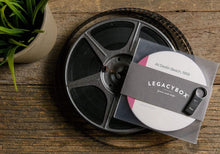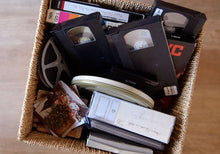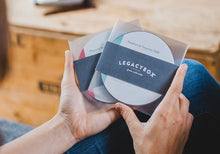Convert 16mm To Digital
Sweet 16. Remember the year you could finally get behind the wheel and drive? Ah! The freedom to see the world and be seen by it in all of your awkward teenage glory. Sure it was mostly back and forth to the mall, but it certainly felt like breaking out of prison.
Do you have any 16mm film treasures hidden away? The film was stored on reels, shown on projectors, and was 16 millimeters wide. If you don’t already know what you have on those reels, it’s high time you find out. Sure it’s hard, like getting a teenager out of bed, but all that groaning and stubborn excuse-making is on you. At the top of the to-do list, you’ve got to transfer that 16mm film to thumb drive, digital delivery through Legacybox Cloud™ or DVD before it deteriorates any further. Give it license to get out and be seen (AKA get converted to digital). Your friends and family will never stop thanking you.
16 millimeter was the first truly experimental format and not all 16mm film could record sound while shooting. Sure, there was Hollywood, but then there was everyone else who didn’t have that kind of money. The industry standard 35mm film was expensive and the equipment was heavy. Unless you had a movie lot and crew, not to mention a pretty penny or two, capturing the world outside your door in moving pictures was an unrealistic dream . Then, in 1923, Eastman Kodak introduced 16 mm film as a less expensive amateur alternative to 35 mm film. Professionals snubbed their nose at what they considered to be an inferior medium. But 16mm unlocked possibilities for home filmmakers, for amateur photographers and artists, educators, travelers, and businesses. The format was used exclusively in World War 2. Kodak commissioned a 16 mm Kodascope Library, from which people could buy or rent films, which only helped promote the format. Films for government, business, medical and industrial clients contributed to a whole network of 16 mm professional filmmakers and related service industries in the 1950s and 1960s. Television production was big on the use of 16 mm, because it freed producers from rigidly operated studio sets. 16 mm film was also one of the first formats to use acetate safety film as a film base. 35mm nitrate film had the drawback of being highly combustible.
The technicians at Legacybox want to help set your footage free and give it new life in the realms that you can see it easily, show it to others with the click of a button, and store it safely for generations to come. We convert 16mm with care, making sure each frame is clean, bright and rendered in the best possible way. In addition to digital files, all your 16mm films will come back to live with you forever. That won’t always be true for your teenagers, so give them the gift of their family history before they go off making their own. Not sure if your film has sound? Find out here!





